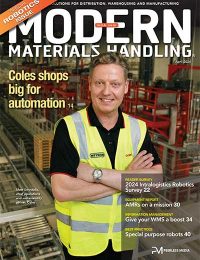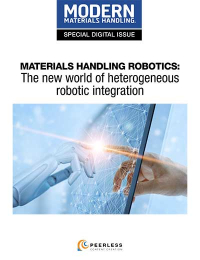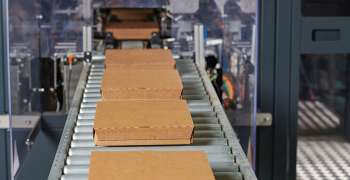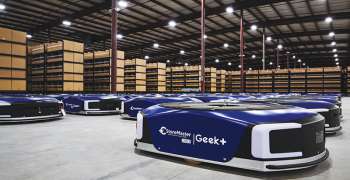Automation: Why we should care about the $15 an hour fast food worker
Rising wages in the services industry could drive materials handling automation
Latest Material Handling News
Two voices of reason on pallet materials 60 Seconds with Bob Trebilcock, outgoing executive editor, Modern Materials Handling Learn from lift truck service history The reBound Podcast: How Pitney-Bowes is innovating with autonomous vehicles. Packaging Corner: Be open to change More BlogsA few years ago, I attended a presentation by a Canadian restaurant chain at a logistics conference. The restaurant operator had built a semi-automated distribution center in Guelph, Ontario. The site was chosen for three reasons: With a number of automotive plants in the area, it had an industrial heritage; there was a solid transportation network; and with 120,000 residents, including a university, there was an apparent pool of available workers.
As things worked out, the company executive’s regret was that his company didn’t implement more automation, especially around case handling and palletizing. The reason: Turnover in the facility was horrendous. Experienced industrial workers preferred working for higher wages in the automotive plants than the relatively low wages in a food distribution center; meanwhile, college students could make nearly the same buck working in the mall as they could in the DC. To illustrate his point, the executive pulled up stats for that shift on his smart phone and learned that he had a 30% absentee rate in the manual case picking area. More automation would have made him less reliant on the local workforce.
I thought about that presentation this weekend reading news reports about fast food workers who are striking McDonald’s and its competitors for a $15 an hour wage. Those same protestors would also like to see WalMart, Target and their mall store competitors pay a living wage to retail clerks.
I have no idea whether the fast food or retail industries will buckle under pressure and raise their wage rates. However, it’s an issue that we in the manufacturing, warehousing and distribution industries should watch. We’re already struggling to staff our facilities, which often have a 50% or more annual turnover even though the pay is better than working at McDonald’s. If I’m a 20-something who can make $15 an hour in the mall, like those the kids in Guelph, I’m going to really think twice about busting my hump picking cases on the second shift.
At the same time, there’s a potential silver lining for materials handling automation: Wage demands could accelerate the adoption of automated solutions, especially the next generation of case and piece picking robots now coming to market that can work next to associates.
That brings me to the second story I was following this week. On the same day fast food workers were striking McDonald’s, the Times reported that Google is making a major investment in robotics. Those robots aren’t going to drive Google cars. Instead, they may very well be adapted to working in retail stock rooms and distribution centers. “A realistic case, according to several specialists, would be automating portions of an existing supply chain that stretches from a factory floor to the companies that ship and deliver goods to a consumer’s doorstep,” the Times reported, adding that the opportunities for robotic automation are massive. “’There are still people who walk around in factories and pick things up in distribution centers and work in the back rooms of grocery stores.’”
In fact, that day is already here, albeit in limited, niche applications. In the December issue of Modern, I wrote about how Genco is using a piece picking robot that works side by side with associates in a package sealing application in its distribution center in Ft. Worth, Texas. This isn’t a science project. Genco has moved from pilot to production. You can watch the robot at work by clicking here.
Now, by all accounts, the robot has limited capabilities at this stage of the game – the payload is about 5 lbs. and it’s a little slow. But in the right application, it works, it’s working and the new process has revealed other ways to take costs out of the process. At $35,000 – Genco’s estimated cost for the robot, tooling and warranty –the robot costs about the same as a $15 an hour associate for one year.
During my interviews with Genco for the December story, Pete Rector, executive VP of technology and lean solutions, said something similar to the experts in the New York Times. The real breakthroughs in robotics will come when we’re able to apply robots that can work side by side with associates in repeatable processes – like case and piece picking. “Think about a robot like Baxter and then you give it Siri,” he said. “You get a robot you can talk to you and it talks back to you. How far is that? It’s closer than you think.”
The $15 an hour fast food worker, if it comes to pass, could create an opportunity for our industry to take automation to the next level – from storage and conveyance to piece picking and handling.

Article Topics
Blogs News & Resources
Two voices of reason on pallet materials 60 Seconds with Bob Trebilcock, outgoing executive editor, Modern Materials Handling Learn from lift truck service history The reBound Podcast: How Pitney-Bowes is innovating with autonomous vehicles. Packaging Corner: Be open to change 60 Seconds with Robert Martichenko of American Logistics Aid Network The reBound Podcast: Looking for talent in all the right places: How Essendant is revolutionizing recruitment More BlogsLatest in Materials Handling
ASME Foundation wins grant for technical workforce development The (Not So) Secret Weapons: How Key Cabinets and Asset Management Lockers Are Changing Supply Chain Operations MODEX C-Suite Interview with Harold Vanasse: The perfect blend of automation and sustainability Consultant and industry leader John M. Hill passes on at age 86 Registration open for Pack Expo International 2024 Walmart chooses Swisslog AS/RS and software for third milk processing facility NetLogistik partners with Vuzix subsidiary Moviynt to offer mobility solutions for warehouses More Materials HandlingAbout the Author
Subscribe to Materials Handling Magazine

Find out what the world's most innovative companies are doing to improve productivity in their plants and distribution centers.
Start your FREE subscription today.
April 2024 Modern Materials Handling

Latest Resources










